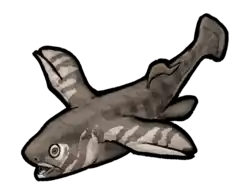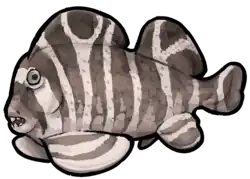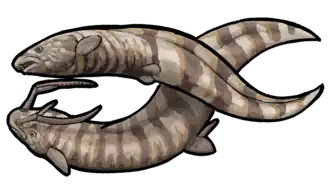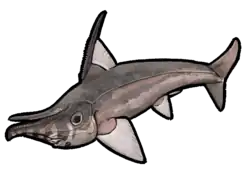Erikodus
| Erikodus Temporal range: Permian
| |
|---|---|
| Scientific classification | |
| Kingdom: | Animalia |
| Phylum: | Chordata |
| Class: | Chondrichthyes |
| Order: | †Eugeneodontiformes |
| Family: | †Caseodontidae |
| Genus: | † Nielsen, 1952 |
| Species: | †E. groenlandicus
|
| Binomial name | |
| †Erikodus groenlandicus Nielsen, 1932
| |
Erikodus is an extinct genus of caseodontid eugeneodont from the Late Permian of Greenland. A single species, E. groenlandicus, is known, which was originally classified as a species of Agassizodus.[1] The genus had a row of rounded, overlapping teeth along the midline (or symphysis) of both the upper and lower jaw, as well as rows of flat, plate-like, rectangular crushing teeth elsewhere in the mouth.
Discovery and naming
Remains of the genus are known from the Guadalupian-age Foldiv Creek Formation of East Greenland.[1] The type species, Erikodus groenlandicus, was originally named as a species of Agassizodus in 1932 by Danish paleontologist Egil Nielsen. Teeth referred to the genus Copodus were also described by Nielsen in 1932[2] In a 1952 publication, Nielsen recognized that the species was distinct from Agassizodus and classified it as a distinct genus, and also recognized that the remains assigned to Copodus were also teeth of Erikodus groenlandlicus.[1][3] Nielsen named the genus in honor of Swedish paleontologist Erik Stensiö.[3][4]
Description
Erikodus is known from teeth, scales, and portions of its cartilaginous skeleton such as the braincase, gills, pectoral girdle and fins,[3][5][6] although detailed descriptions have only been published for the teeth.[7] Symphyseal (midline) tooth-whorls were present in both the upper and lower jaws, which were proportionally large and had rounded, unfused, tightly-packed tooth crowns. The anatomy of the lateral teeth which sat further back in the jaws was similar to that of the related genera Agassizodus and Caseodus. Erikodus' teeth were rugose and ornamented,[1] and were composed of tubular dentin (a form common in holocephalan fishes) without an outer covering of enameloid.[4][5] The palatoquadrates (upper jaws) were fused to the braincase.[6]
References
- ^ a b c d Ginter, Michał; Hampe, Oliver; Duffin, Christopher J. (2010). Handbook of paleoichthyology: teeth. München: F. Pfeil. p. 121. ISBN 978-3-89937-116-1.
- ^ Nielsen, Eigil (1932). "Permo-Carboniferous fishes from east Greenland". Meddelelser om Grønland. 86 (3): 1–63..
- ^ a b c Nielsen, Egil (30 August 1952). "On new or little known Edestidae from the Permian and Triassic of East Greenland". Meddelelser om Grønland (144): 5–55.
- ^ a b Duffin, Christopher J. (2016). "Cochliodonts and chimaeroids: Arthur Smith Woodward and the holocephalians". Geological Society, London, Special Publications. 430 (1): 137–154. doi:10.1144/SP430.9. ISSN 0305-8719.
- ^ a b Bendix-Almgreen, Svend Erik. "Palaeovertebrate faunas of Greenland". Geology of Greenland. doi:10.22008/GPUB/38226.
- ^ a b Orvig, Tor; Nobel Symposium, eds. (1968). Current problems of lower vertebrote phylogeny: proceedings of the 4. Nobel Symposium held in June 1967 at the Swedish Museum of Natural History (Naturhistoriska riksmuseet) in Stockholm. New York: Interscience Publ. [u.a.] pp. 153–205. ISBN 978-0-471-65713-2.
- ^ Zangerl, Rainer (1981). Chondrichthyes 1: Paleozoic Elasmobranchii (Handbook of Paleoichthyology). Friedrich Pfell (published January 1, 1981). pp. 2–3, 74–94. ISBN 978-3899370454.




